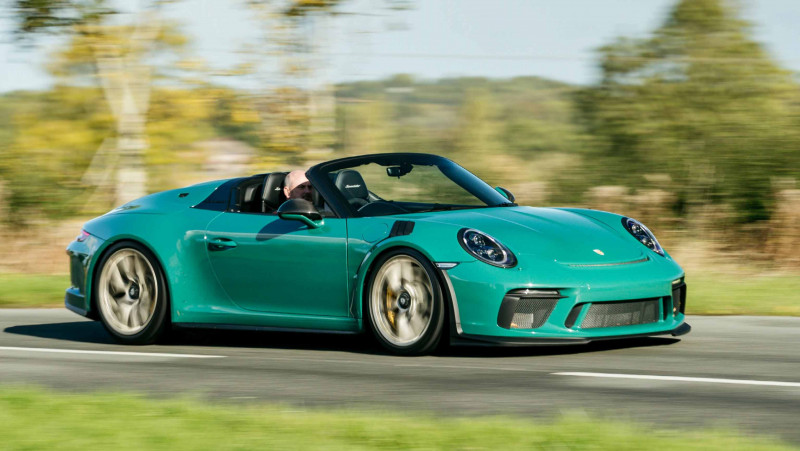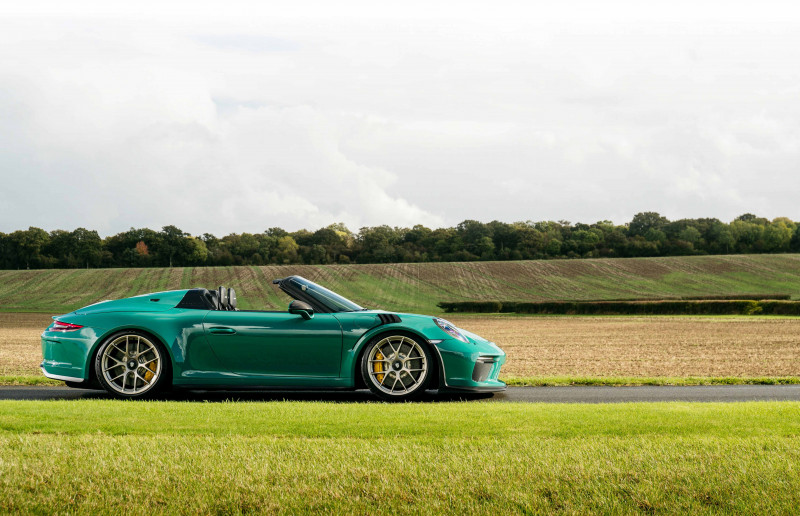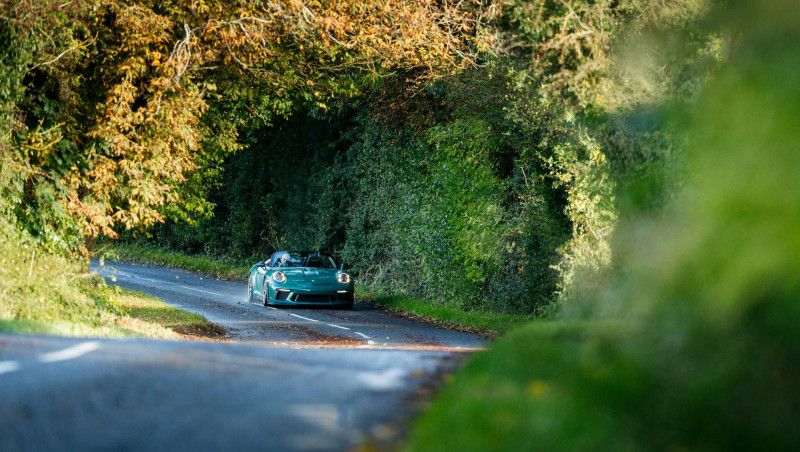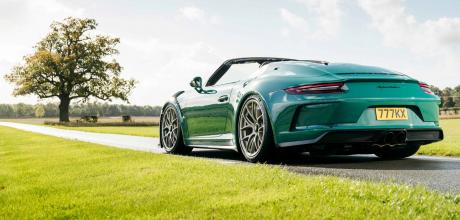2019 Porsche 911 JCR Speedster 991 test drive
JCR takes the only open-topped 911 product to hail from Porsche’s GT department and applies some motorsport thinking, to tremendous effect. Written by Kyle Fortune. Photography by Ali Cusick.
LATEST SPEEDSTER GETS GLORIOUSLY MODIFIED: FULL ROAD TEST INSIDE
Porsche’s open-topped 991 is already a collector’s gem. We drive a modified example from JCR Developments
The call came late on Tuesday night. Tomorrow’s off. With the rain outside bouncing with enough ferocity to consider boat building and lining up two by two, JCR’s Jonny Cocker has sensibly suggested that the planned Donington track day drive in the JCR 991 Speedster might not be particularly wise. Not that he’s precious about it: the Speedster is used, it’s very much a working car, but as such it’s on a set of Cup 2 R tyres that have seen a bit of track work, and there’s no time to get suitable replacement rubber. There’s another option, though: it’s forecasted to be dry on the other side of the country, that usefully being where both JCR and I are located, so plans are changed and we’ll drive the Speedster on road rather than track.

The last 991 built was one of the 1,948 Speedsters, which makes the open car significant for Porsche as well as the GT department. As such most of them are secreted away in collections, untouched, undriven with mileages kept low with an eye on future values. Cocker’s unapologetic about using his, buying it as he recognised the Speedster would allow JCR a shortcut to developing parts for the 992 GT3. Primarily, but not limited to, exhausts, JCR is specialist in producing lighter, performance-enhancing exhaust systems that work with the existing OEM parts.
The Speedster, then, is his JCR’s rolling test bed, it replacing a GT4 and a brace of 991.1 GT3 RSs before it, it serendipitous that the fitment of what would essentially be the same engine as the 992 GT3 would be situated in such a head-turning, limited-series model. Cocker explains: “The prime reason for getting the car was the engine and that it enabled us to get a head start with 992 GT3 development. The fact that it’s a Speedster helps, because realistically, nobody else is going to take what’s a £300,000 car and start pulling it to pieces, repaint it and change it. From a development point of view for us, it’s cool, while from a marketing standpoint it’s fantastic because it just gets so much attention.”

He’s not wrong, either; the reach of social media had made me aware of the JCR Speedster, and a chance meeting at Henry’s Car Barn (HCB) cars and coffee event in Warwickshire is where we bent Cocker’s ear asking for a drive. One week later, we’re back at HCB holding the Speedster’s key, it also being the home of Logic VPC, the company that did the colour change on the JCR Speedster. Originally painted Crayon, it’s now Smyrna green – Logic used its peelable paint process where a clear, peelable layer covers the original paint, before conventional car paint, here with added silver glass flake, is painted over the top. The result is sensational, that glass flake not changing the base colour like a metallic flake would, but instead adding some richer sparkle in direct sunlight. Cocker chose it after seeing it on a 356 Speedster, and he’s picked well, because it suits the 991 Speedster perfectly.
There’s some of that sun today too, and despite a damp drive over from JCR’s base the roads are now drying. Cusick’s busy with his camera while there’s a break in the weather, while Cocker and I discuss what JCR has changed with its Speedster. The most obvious visual difference, other than that colour change, is the 991.2 RS front end. I say obvious, but with Speedsters not exactly a common sight, all but the well-informed might miss it.
“We’ve done a full 991.2 GT3 RS front end: bumper, wings, all the front underfloor aero, all of the suspension components. That is twofold, because from an aero standpoint it’s great, it’s more downforce; in percentage it’s more, in actual kilos terms it’s not huge, but it all helps. More usefully it’s enabled us to put a bigger tyre on the front and all the RS suspension components because it’s got a much wider (30mm) front track,” explains Cocker.
The wheels are magnesium BBS items, Cocker saying they’re the result of a US customer commissioning BBS to make 30 sets so they could have a single set. They are 20-inch twin six-spoke wheels with the same width and offset as the GT3, the fronts weighing 6.8kg and the rears 8.3kg – a massive saving of 3.8kg per corner on the front axle, and a 3.9kg saving per wheel at the rear.

Fitted here with Michelin Cup 2 R tyres, in 245/35 ZR20 front and 305/30 ZR20s at the rear, the brakes are changed for Surface Transforms ceramic discs, with RSC1 Pagid pads; Cocker says this setup runs cooler, bites better and delivers smoother modulation on both application and release. Those Surface Transforms discs can be re-finished as many as four times too, which is an enormous cost benefit if you’re tracking them, while they’re also slightly lighter than the PCCB disc. Cocker’s working on some titanium bells to replace the Surface Transforms stock items, which he suggests will be 50 per cent lighter again, and offer greater cooling.
The current reduced unsprung mass hangs off the Manthey-Racing GT3 RS MR coilover kit with threeway front and three-way rear adjustable dampers. Cocker picked a three-way setup at the rear as the four-way system, a benefit for a higher downforce loading of an RS, just isn’t necessary here. It sits around 40mm lower all round, it riding a touch lower at the back than the front to make the rear underfloor work better, while balancing out that harder working front. JCR is working on a rear underfloor setup which should let it lift the rear slightly. Presently it’s stock underneath the back but helping at the rear, visually at least, is the 991.2 Sport Design Package spoiler with its kicked, longer lip – changing, for the better, the rear look without being too overt.
It’s these kinds of details that define JCR’s Speedster. Overall, it’s been revised with a subtlety that really works, it undeniably more assertive in its overall appearance, yet achieving that without looking modified. The rear spoiler, says Cocker, “is a nice addition, that looks very factory. Actually the aero balance is good, it’s not all on the front, it doesn’t feel like a GT3 RS without any rear wing by any means. It’s more, to me, stable, because it was so weighted to the rear anyway. The front had felt floaty before, but we’ve been able to dial it in massively with the dampers, the Cup 2 R tyre, the whole chassis, the damper and everything has been tuned around that tyre. That tyre is unbelievable, it’s like cheating.”
Elsewhere Cocker says 99 per cent of his customers aren’t interested in cracking open the ECU to work on it, so the company’s focus is all around the principles of getting air into and out of the engine more efficiently. JCR has a huge range of options to do so, its exhaust systems being modular to allow any number of combination of choices to achieve your intended goal, be it sound, performance or weight reduction. The promise with all of them is you’ll get a combination of all three.
Cocker explains: “On the Speedster as it stands, we’ve got development manifolds and the particulate filters are removed, there’s a different cat section in there. We’re just at the very early stages of development, the next stage is to get the first complete development set on, and then work from there. The rear section again is modular so there’s a complete direct replacement for the rear silencer, we’ve got a titanium non-silenced system on that – we do three: silenced, non-silenced, and a valved version. The silenced and non-silenced have a valve delete module, so the valves are removed from the exhaust, but it keeps the ECU happy; if you remove them it just kicks off, limits the revs and does all sorts of weird things.” There are weight savings: the manifolds are Inconel, which drops between 3-4kg a side, and the exhaust, made of ASNEX titanium, depending on the final configuration, drops around 15kg over the stock parts.
JCR tests all of this, using lap times around Silverstone to benchmark its changes, with Cocker setting the times during product development. His qualification to do so is his motorsport background: years of racing and testing, including four outright championship wins – the most relevant ones to his Porsche work being the 2004 N-GT British GT Championship title in a 911 GT3 RSR and the 2005 Asian Carrera Cup title. His goal back then was to be a Porsche factory driver but, sensibly, Cocker always had an eye on a future outside motorsport. “I always loved Porsches, I wanted to drive cars that I liked the look of. Most racing drivers actively have no interest in cars, but I’ve always had more of an interest in cars than motorsport,” he says. Cocker set up JCR in 2014, with the goal of approaching cars from a motorsport angle, putting his experience into finessing their performance, and in 2018 he was able to realise his goal of working on Porsches by developing JCR’s first 991.1 GT3 RS.
The Speedster is the current iteration of the company’s growth, Cocker delighted that at any given trackday a number of GT3/GT4 and other Porsche models will be running JCR products. There’s no track today, but getting in the cabin, that track focus is a little bit more obvious with JCR adding a Alcantara wheel, shift boot and knob, as well as its own seat inserts. The flat six fires with a deeper timbre than I remember from a stock Speedster, the almost Italianate and rather uncharacteristic musicality of the Speedster’s standard exhaust being replaced here with a more authoritative and purposeful sound, that’s more immediately recognisable as a Porsche flat six.
Cocker hadn’t mentioned anything in relation to the manual shift, but the very first push through the gate reveals it’s been significantly changed, later questioning revealing that there’s now a billet assembly replacing the stock one, with all the plastic and rubber bushings removed for a more direct shift. That alone is pleasingly transformational, the shift feeling beautifully mechanical and positive in its movement, weighting and accuracy, appreciably enhancing what was already a hugely appealing aspect of the Speedster’s interaction. The steering feels equally rich in information, its weighting such that there’s enough heft to require a bit of effort off-centre, the reward for doing so being a front axle that’s extremely faithful in its response. It’s not as hyperactive as the current 992 GT3, the Speedster’s crispness here not to be confused with corruption – it delivers feel and accuracy, yet it’s not so busy that taking a hand off it to shift that brilliant six-speeder results in deviation from your intended trajectory.
Cocker says there’s 3 degrees of camber on the front, the rear being 2.7 degrees, highlighting that above 3 degrees on the road is too much, creating unwelcome distractions. It seems here they have found a sweet spot, precision mixed with feel and alertness, resulting in a hugely informative wheel. What’s so impressive is the ride quality, achieved despite suspension that’s significantly lower and obviously more focused in its intent. There’s a quality to the damping, which like the rest of the package elevates the performance without being detrimental to the usability.
After a few tentative miles on the road to allow the tyres to get some heat in them, the initial concerns relating to the suspension’s singularity simply don’t manifest. Indeed, for something that promises GT3 RS rivalling – and potentially bettering – lap times, the Speedster rides very convincingly, the anticipatory wincing on spotting pock marks or difficult surfaces on the road not borne out with any crashing or jarring. The significant reduction in rotating and unsprung mass, as well as the sophistication of the damping, is demonstrated here to tremendous effect. The brakes, not tested at anything more than legal road speeds here reward with fine feel and bite, particularly during the initial push, where input is readily translated to retardation.
Like the brakes, opportunities to really exercise the engine’s full rev range are limited on the road, but on the occasions the revs get close to and touch the red paint the intensity with which it does so is undiminished, enhanced even, with the more satisfying sounds from the exhaust making us wish for more time in it. There’s a touch more power, Cocker saying they’re aiming ultimately for around 545hp, but it’s about 20hp shy of that presently. He concedes it’s not really a car that needs more power, but if it can be achieved by efficiencies via JCR’s developments then that’s not without appeal. The fact it’s more overt and stronger in its note is similarly attractive, that done without the sounds emanating from it approaching obnoxiousness – the Speedster, as much as a car that looks like this, is able to blend quietly into traffic when you’re in less of a hurry and, more significantly given its likely audience, pass noise regulations at a trackday.
That’s an impressive quality, because so often changes to take a car in one direction remove so much from the whole as to be unsatisfactory for a larger proportion of the time. That’s not the case with the Speedster, JCR’s revisions taking an already polished, rounded package and elevating it to another level again, without being in any way compromising as a result. That, today, is in spite of the Cup 2 R tyres, which while coping admirably given the less than perfect conditions for them, did temper enthusiasm slightly on cool, sometimes damp roads. Regardless, the JCR Speedster drive is revealing in that it demonstrates convincingly that there’s always room for improvement, particularly in relation to Porsche’s GT products. It’ll be interesting to see where JCR takes it, because I’d argue that it’s damned near perfect, but might I suggest Silverstone, sometime next summer, just to be sure…?
Total 911 verdict
JCR does the unthinkable and messes with Porsche royalty, to very convincing effect. The Speedster comes from the GT department so applying more motorsport thinking to it is no bad thing. Especially when the result is as convincing as JCR’s changes, it all being done hugely sympathetically, the biggest compliment being that if Porsche itself had taken the Speedster further, it would likely have come up with something much like this.
“From a development point of view for us, it’s cool, while from a marketing standpoint it’s fantastic because it just gets so much attention”
LEFT Porsche’s latest 911 Speedster has been taken to the next level by JCR, using the car as a development vehicle for its own 991 and 992 GT products.
BELOW Wheel arch vents are taken from a 991.2 GT3 RS.
RIGHT New seat inserts are a visual upgrade, a revised shift however is something the eye won’t readily see.
LIKES + An owner, albeit a company, that is prepared to use a Speedster properly, and also isn’t afraid to modify it to suit their own ambitions – and here, very admirably indeed
DISLIKES — Porsche only built 1,948 Speedsters and few if any owners will be brave enough to follow JCR’s example


